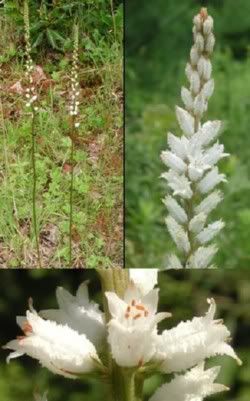

Ague Root (Aletris farinosa)
Folk Names: Ague Grass, Ague Weed, Aletris, Aloeroot, Backache Root, Bettie Grass, Bitter Grass, Black Root, Blazing Star, Colic Root, Crow Corn, Devilís Bit, Mealy Starwort, Rheumatism Root, Stargrass, Star Root, Starwort, True Unicorn Root, Unicorn Plant, Unicorn Root
Description: Ague Root is native to North America. A perennial of lily family, it prefers grassy or sandy, acidic, and consistently damp soil. It grows in sunny areas from the mossy woodlands in Northeastern America and Southern Canada to the Gulf of Mexico and West to Minnesota. The rhizome root is thick and fibrous, growing in a somewhat horizontal direction. The root is intensely bitter, though this quality this fades with time and drying, and has a slight odor. The plant sports no stem. Instead there is a grass-like rosette of yellow-green, lanceolate, spreading basal leaves two to seven inches long. Ague root grows a one to three feet flower stalk from May to August with many small 1/4-1/2 inch long flowers in terminal spike-like racemes. The tubular-oblong, bell-shaped flowers are white with a touch of yellow. The ovoid or triangular, leathery fruit contains many oblong, ribbed seeds. The seeds are fleshy and oily.
Effects:
Planet: Uranus
Element:
Associated Deities:
Traditions:
Ague root is endangered or threatened in some areas so be careful of wild harvesting.
Magic:
Ague Root is used to keep evil at bay and gain protection from spirits. It may be sprinkle around your home or a cross may be formed with the roots just outside the entry to a home. A piece may also be carried for this purpose. Sprinkle the herb in the path of enemy to cause confusion and uncertainty.
Use in hex-breaking and uncrossing rituals and mixtures.
Known Combinations:
Mix equal parts Ague Root, Patchouly, Myrrh, Wood Betony, and Salt Peter to make incense designed to thwart your enemies. While it burns say:
Burn, incense, burn,
Consume the curse which is upon me,
Turn, incense, turn,
Send the evil back from hence it comes.
Medical Indications: Use dry roots only. The fresh root can cause dizziness, intestinal pain, and vomiting. Fresh, it is very much a cathartic, emetic, and narcotic. Parts Used : Gather the root in fall. Use it dried or granulated. It is best made into an alcohol tincture.
Ague Root acts as an antispasmodic and pain reliever, toning the stomach and uterine muscles. This makes it valuable in preventing habitual miscarriage, dysmenorrhea, and memorrhagia. It may be used as a decoction for indigestion and other digestive problems or in tincture form for flatulence and colic.
Appalachian folk medicine says to mix the extract with brandy or whisky for treatment of rheumatism, and a poultice of the leaves may be used for an aching back or sour breasts. The Native Americans made a tea of the root and leaves for stomachaches, colic, dysentery, menstrual disorders.
Nutrition:
None Noted
Mercantile Uses:
None Noted